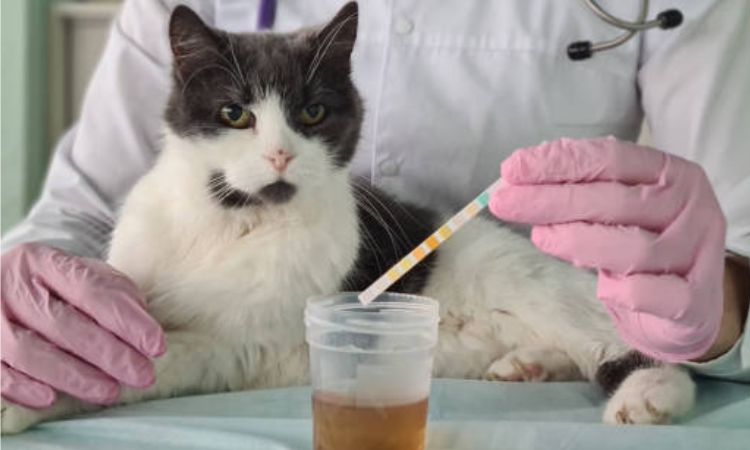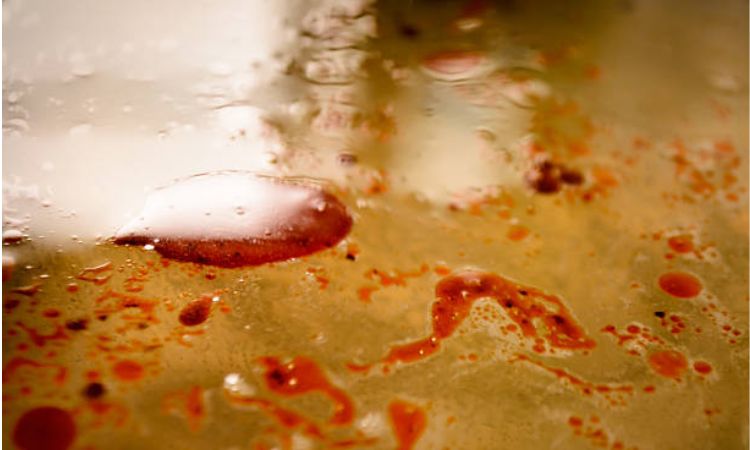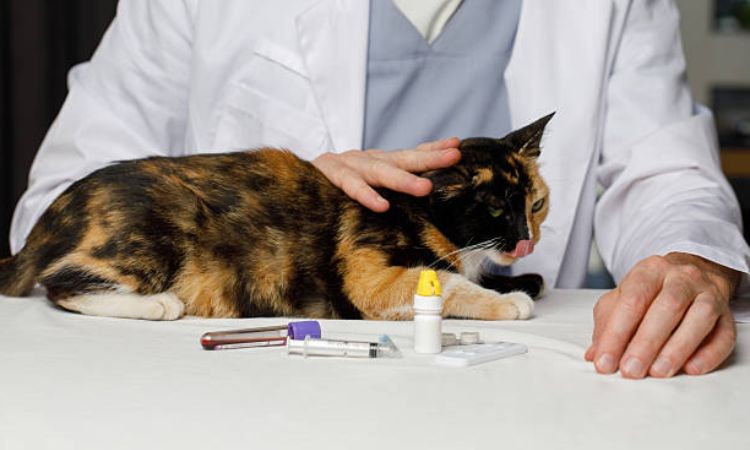Spotting blood in your cat’s urine can stop you in your tracks—it’s a moment of panic no pet parent ever wants to face. While the sight is alarming, it’s also a signal that something beneath the surface needs attention.
At Nexus-Pets, we’ll walk you through the possible causes, key symptoms to watch for, and the steps you can take to protect your cat’s health and peace of mind.
Common Causes of Blood in Cat Urine

1. Urinary Tract Infections (UTIs)
UTIs occur when bacteria invade the urinary tract, usually through the urethra, and multiply in the bladder. This leads to irritation and inflammation of the bladder lining, which can cause blood to appear in the urine. Alongside hematuria, cats with UTIs often show signs such as frequent trips to the litter box, straining while urinating, producing only small amounts of urine, or vocalizing in discomfort. Some cats may also lick their genital area excessively.
2. Feline Lower Urinary Tract Disease (FLUTD)
FLUTD is a term that covers a group of urinary conditions commonly seen in cats. These issues are often linked to stress, obesity, poor diet, or dehydration. Cats with FLUTD may strain to urinate, pass urine outside the litter box, or display pain during urination. Blood in the urine is a frequent symptom, and in some cases, the condition can progress to dangerous urinary blockages if left untreated.
3. Bladder Stones (Urolithiasis)
Bladder stones are hard mineral deposits that form inside the bladder. As they rub against the bladder lining, they can cause irritation, inflammation, and bleeding. These stones can also obstruct the urinary tract, making urination painful or difficult. Certain risk factors, such as diet high in minerals, dehydration, and specific breeds (like Persians or Burmese), make some cats more prone to developing bladder stones.
4. Urinary Blockage (Life-Threatening Emergency)
A urinary blockage is a complete obstruction of the urethra, preventing urine from passing. This condition is far more common in male cats due to their narrower urethras. Because urine cannot leave the body, waste products quickly build up in the bloodstream, leading to life-threatening complications. Bloody urine, straining with no results, or constant visits to the litter box with no urine output are critical warning signs. This situation requires immediate veterinary intervention to save the cat’s life.
5. Trauma or Injury
Physical trauma—such as a fall, being hit by a car, or fighting with another animal—can injure the bladder, kidneys, or urinary tract. Such injuries may lead to internal bleeding that appears as blood in the urine. Depending on the severity of the trauma, additional symptoms like lethargy, pain, or difficulty moving may also be present.
6. Cancer or Tumors
Though less common, cancers or tumors of the bladder and urinary tract can cause bloody urine. Tumors irritate or invade the lining of the bladder, resulting in bleeding. Warning signs that may suggest cancer include persistent hematuria, weight loss, reduced appetite, and a decline in overall health. Any ongoing or unexplained blood in the urine should be evaluated by a veterinarian to rule out this serious cause.
7. Other Causes
In addition to the conditions above, several other health issues can lead to blood in the urine. Chronic kidney disease may damage blood vessels in the urinary tract. Blood clotting disorders, whether inherited or acquired, can also result in hematuria. In some cases, certain medications may have side effects that include urinary bleeding. A veterinarian’s evaluation is crucial to identify these underlying causes and provide appropriate treatment.
Symptoms to Watch for Alongside Bloody Urine
When blood appears in your cat’s urine, it rarely comes alone. Cats often show other clinical signs that can help you and your veterinarian determine the underlying cause. Key symptoms include:
- Straining or difficulty urinating: Your cat may spend a long time in the litter box, pushing hard with little to no urine output.
- Frequent but small attempts to urinate: Instead of passing normal amounts, cats may make repeated trips, producing only drops of urine.
- Crying out or signs of pain in the litter box: Vocalizing, restlessness, or sudden attempts to leave the litter box can indicate discomfort.
- Licking the genital area frequently: Cats often groom excessively around the genitals in response to irritation, infection, or pain.
- Urinating outside the litter box: This may happen if your cat associates the box with pain or urgency, leading them to urinate on soft surfaces like rugs or bedding.
- Lethargy, loss of appetite, or vomiting: These systemic signs often suggest the problem is more serious, such as a urinary blockage, infection, or underlying disease, and require immediate veterinary care.

Treatment Options for Blood in Cat Urine
When a cat is urinating blood, it is always a sign of an underlying medical issue that requires attention. Treatment depends entirely on the cause, so veterinary evaluation is essential. Below is a detailed overview of the main treatment approaches veterinarians may recommend:
1. Medications
Medications are often the first line of treatment, especially when the underlying cause is an infection or inflammation. Common options include:
- Antibiotics: Used when bacterial urinary tract infections (UTIs) are diagnosed. A urine culture often guides the selection of the most effective antibiotic.
- Pain relief and anti-spasmodic drugs: These help reduce discomfort, bladder spasms, and inflammation. Pain management is crucial for cats with conditions such as feline idiopathic cystitis (FIC) or urinary stones, as these issues can be extremely painful and stressful.
2. Special Diets and Hydration
Dietary management plays a vital role in both treatment and prevention of urinary issues:
- Prescription urinary diets: These are specially formulated to dissolve certain types of bladder stones and to prevent new stones from forming. They may also help maintain a healthy urinary pH to reduce irritation of the bladder lining.
- Hydration support: Adequate water intake is essential to flush the urinary tract and reduce urine concentration. Options include feeding wet food, providing multiple water bowls, or installing cat water fountains to encourage drinking. Well-hydrated cats are less prone to forming crystals or stones, which can aggravate hematuria.
3. Emergency Care
Some situations require immediate veterinary intervention, particularly in male cats, who are more prone to urinary blockages:
- Catheterization: If a cat cannot urinate due to a urethral blockage, a catheter may be inserted to relieve the obstruction. This procedure often requires sedation and careful monitoring.
- Hospitalization: Cats with impaired kidney function, severe dehydration, or systemic illness may need hospitalization for intravenous fluids, monitoring, and supportive care. Rapid treatment is critical, as untreated blockages or kidney issues can be life-threatening.

4. Surgery
In some cases, medical and dietary management may not be sufficient:
- Bladder stones: Certain types of stones cannot be dissolved through diet alone and require surgical removal.
- Urinary tract tumors or polyps: Surgery may be necessary to remove abnormal growths in the bladder or urethra.
Post-surgical care usually involves hospitalization for pain management, monitoring urine output, and ensuring a smooth recovery.
Seeing blood in your cat’s urine can be alarming, but remember that many of the underlying causes are treatable. The most important step is to contact your veterinarian right away. With a prompt diagnosis and the right care plan, you can help your cat feel better and get back to their happy, healthy self.






